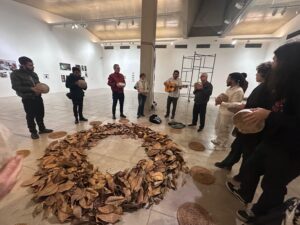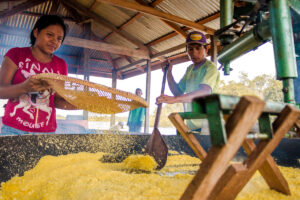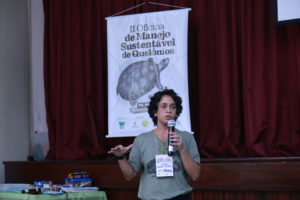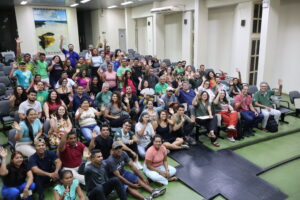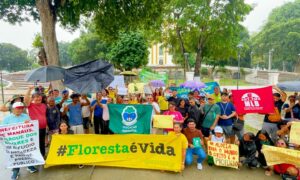By Elzineide do Carmo e Maria Julia Ferreira
Translated by Luiza Campos
In the first week of October, a team of researchers from the Getulio Vargas Foundation (FGV), in partnership with researchers from the Instituto Juruá, visited the Mid-Juruá territory as part of the transdisciplinary project “Innovation for the Creation of Sustainable Values: Understanding Global Value Chains in the Amazon,” from the Amazônia +10 initiative. The project investigates the challenges and opportunities of developing innovative strategies for Global Value Chains, enabling the optimization of the local sociobioeconomy by integrating economic, social and environmental perspectives.
During the visit, researchers from both institutions went to the vegetable oil processing industry of the Association of Agroextractivist Residents of the Uacari Sustainable Development Reserve (AMARU) in the municipality of Carauari. The researchers had the opportunity to understand the stages of the oil extraction process from the commercially sold species (Carapa guianensis and Astrocarium murumuru), commonly known as andiroba and murumuru, respectively. In addition to AMARU, the researchers visited the Mixed Cooperative of Sustainable Development and Solidarity Economy of the Mid-Juruá Extractive Reserve (CODAEMJ), located in the Roque Community. There, they were able to learn more about another plant where the region’s seeds are processed for the extraction of vegetable oils from the native forest. According to the extractivists and technicians, one of the major challenges faced during processing is obtaining andiroba oil that meets market quality standards. This is because if the drying process is not done correctly from the moment the seeds are harvested from the forest, the andiroba oil becomes too acidic and buyers do not accept it. They also explained that in the last harvest, in 2024, this problem did not occur, as partner institutions and community-based organizations planned and supported each other to reduce the time between collection and processing, which resulted in production that met the accepted standards for commercialization.
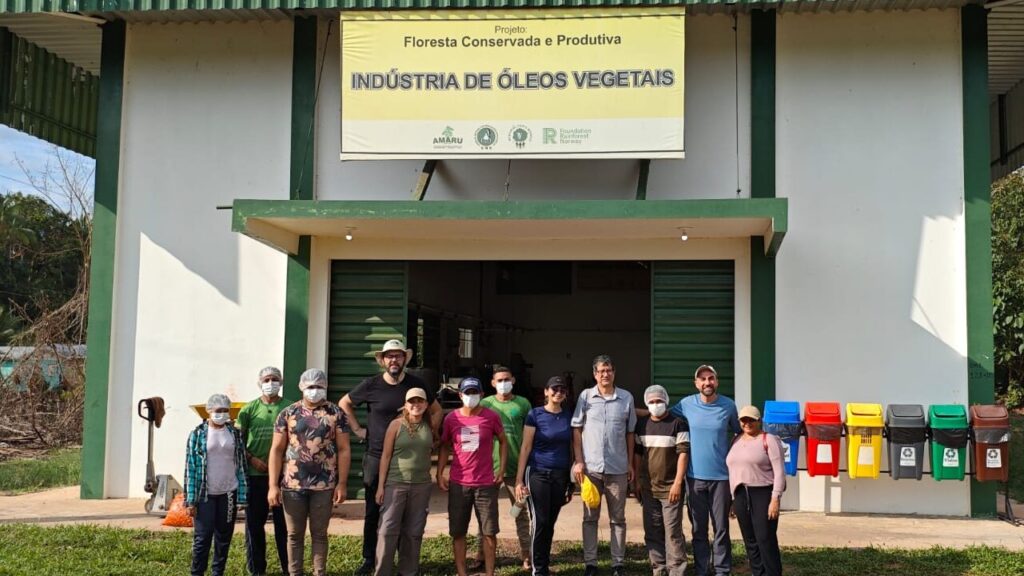
Photo: IJ Collection.
During another visit made by the team of researchers, it was possible to learn about the Ecological Soap Factory, coordinated by the Association of Agroextractivist Producers of the Nova Esperança Community in the Extractive Reserve of Mid-Juruá (ANNE). In the soap factory, predominantly managed by women, a range of cleaning products is produced, such as: liquid soap, fabric softener, detergent, and disinfectant with essence from leaves and/or peels of various species sourced from the forest. In addition to production, workshops for young people and children from the community also take place at the soap factory. According to Luciene, who is responsible for the soap factory and the plant nursery which supplies raw materials for the products, the workshops were recently offered to neighboring communities. She also highlighted that, although they do not yet produce on a large scale, it is expected that in the near future the products will gain recognition and reach a promising market, enabling greater income generation for the women involved in the process.
The researchers also had the opportunity to visit the Lago Serrado community, where the management of tambaqui (Colossoma macropomum) and pirarucu (Arapaima gigas) was taking place. On the day of the visit, the researchers participated in a conversation with the president of the Association of Agroextractivist Residents of Lower Mid-Juruá (AMAB), who spoke about the importance of sustainable management for the preservation of fish species and the difficulties faced by fishers in monitoring the lakes. In addition to the technical visits to the communities and community-based organizations, the researchers interviewed the manager of the Uacari Sustainable Development Reserve (Gilberto Olavo – SEMA-AM/DEMUC) to gain a broader understanding of the management process of protected areas in the region. Gilberto emphasized the importance of local partnerships in promoting more effective territorial protection and generating income for the traditional populations of Mid-Juruá.
According to José Antônio Puppim de Oliveira, the project coordinator, it was an excellent experience to understand how the processing of pirarucu and the commercialization of oilseed seeds in the region work. He emphasizes that “being in the territory during this period was important to understand how climatic events affect these value chains, as the severe drought has significantly impacted the region.” The professor at FGV-EAESP and researcher at the Center for Sustainability Studies, André Pereira de Carvalho, adds about the importance of fieldwork like this, because “understanding the community members’ perspectives and having direct contact with their daily lives is essential for a deeper understanding of the challenges related to the viability of sociobiodiversity chains.”
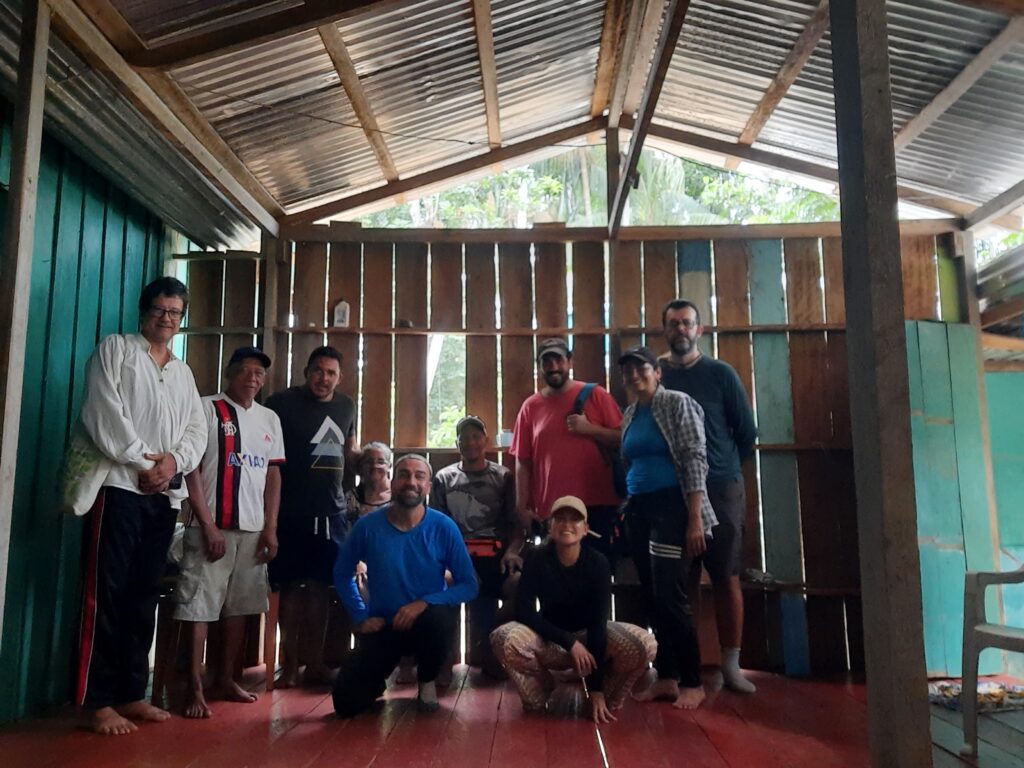
Photo: IJ Collection.
Michel Xocaira Paes, a researcher from the Public Management department at FGV/EAESP, emphasizes that the visit was essential for FGV and the Instituto Juruá to “continue collaborating on practical actions to improve the quality of life of local populations, who are the ones capable of contributing to keeping the forest standing and showing the world a new model of development.” Furthermore, the group of researchers emphasizes that the project will allow for a more accurate diagnosis of the challenges faced by the communities involved in the sociobiodiversity chains in the region, which is fundamental both for developing the concept of the Amazon bioeconomy and for demonstrating its practical application. José Antônio Puppim de Oliveira finally reinforces that “this project is important because it aims to strengthen the productive chains, and this may help to energize the local bioeconomy and provide more added value for the communities of the Mid-Juruá.”

